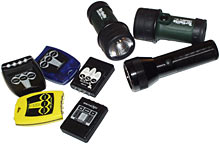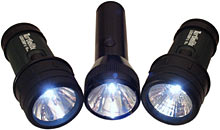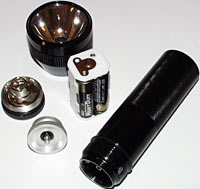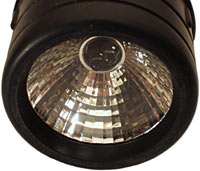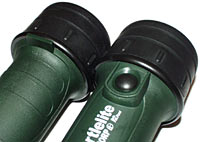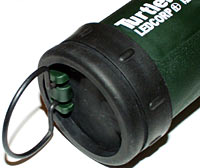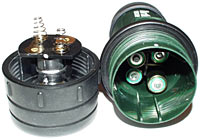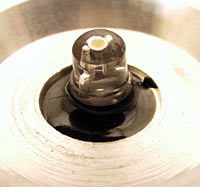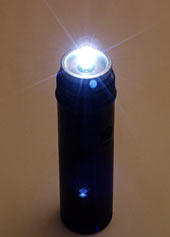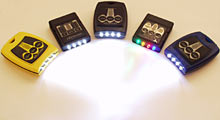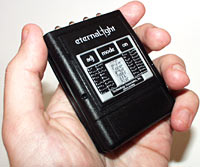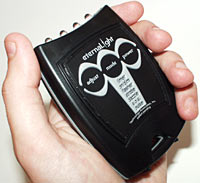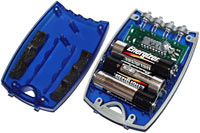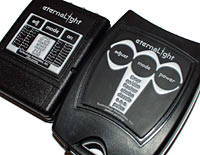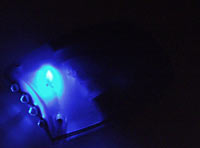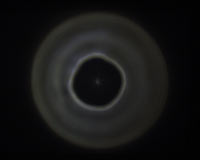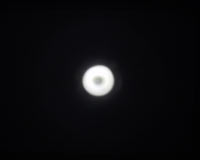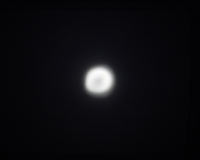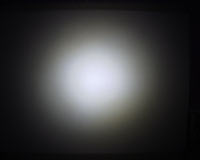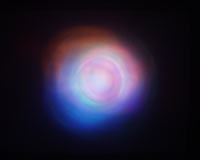
Comparison: LEDCorp and Technology Associates LED flashlights
Review date: 26 April 2001.Last modified 03-Dec-2011.
Most of the world's portable light producing devices use an ingenious but, you've got to admit, fundamentally weird technology. They just pass electricity through a very small coiled thread of metal that gets very very hot as a result, and glows.
Tiny bits of super-hot metal are not renowned for lasting a very long time, so it's amazing how long cheap light bulbs last. There's technological evolution for you. But they still burn out over time, and die quite easily if they're subjected to shock.
High intensity Light Emitting Diodes (LEDs) don't have these problems. They're functionally shockproof, they last a very long time indeed (tens of thousands of hours of light, at least), and they can now match or beat the efficiency of the better filament lamps.
The light output per LED still isn't that amazing - if you want a lot of light, you have to use a lot of LEDs - but a single high intensity LED can still give you as much light as a small hand-held filament flashlight, with no trouble at all.
For this reason, I like LED lights.
A Photon Micro-Light lives permanently on my keychain, and my Technology Associates EternaLight Raven (which I review here) gets a lot of use for ordinary night-time flashlight duty. It's the only torch (USAnians please note - "torch" is Commonwealth-speak for "flashlight") that lets you turn a three-in-the-morning pad to the bathroom into a Disco Inferno experience, at the touch of a button.
The makers, by the way, want you to call this last gizmo a "Rave'n". I choose, instead, to strike a blow for typographical traditionalism.
Neither the Photon nor the Raven is a real general purpose flashlight, though. My Photon is the brightest model they make - but that means it's got a turquoise LED, and makes everything look like an episode of the Twilight Zone. And it still isn't that bright, really. With no focus adjustment, it's hopeless for anything at much of a distance. OK, that's amazing performance from something little bigger, and no heavier, than a key. But still.
The four-colour Raven has a decent amount of light output and surprisingly normal colour rendering, but it too lacks focus adjustment.
In fact, LEDs in general are fixed focus devices, because of their basic design. They have a little light-emitting pit in the middle, and a plastic lens (clear plastic, for all current high intensity LEDs) moulded over it. The position of the light emitter relative to the end of the lens determines the LED's beam angle.
Even the narrowest beam LEDs have about a six degree beam angle. At a distance of ten metres, that'll already be a two metre circle. Most LEDs have a beam angle of around 15, 23 or 30 degrees, so they're even less useful as spotlights.
Not that you necessarily want a spotlight, of course. If you're using a torch for seeing where you're going, what you're working on, or where that thing you just dropped went, a broad pool of light is more useful.
And LEDs are great for that. They give you a very even illumination, tapering off very smoothly around the edges, without all the "bullseye" artifacts of ordinary reflector-type flashlights.
It'd still be nice if you could get an LED flashlight with a zoom beam like a normal twist-the-end Mag-Lite clone, though.
Well, you can. I'll show you it in a moment.
Since LEDs can have their output controlled by pulsing them rapidly, and since they don't care how often they're turned on and off, you can also do all sorts of funky tricks with multi-LED flashlights that contain a little microcontroller. That's Technology Associates' area of expertise, and they do all-white-LED lights as well. I got some of those to play with, too.
On with the show!
Mutant LEDs
LEDCorp make LED flashlights, and LED globes that you can put in ordinary torches as well. They've figured out a way to make LEDs behave like ordinary bulbs, and work with ordinary reflectors.
Here are three of their flashlights. The one on the left is a spot-beam single-LED "Turtlelite", which costs $US19.95. The one on the right's a two-LED wide-beam "Turtlelite II", which costs $US27.95.
LEDCorp apparently ran out of good names when they came up with the one in the middle; they just call it "Our Best Aluminum Flashlight". It's got a proper adjustable beam, and it costs $US29.95.
I went for a walk on a foggy night with this flashlight, and felt very, very Fox Mulder-ish. OK, it's not got the light output of my giant six D cell Mag-Lite with its stock bulb, let alone the blinding power of large-reflector hand-held lanterns and spots. But it's white. Pure, untinted, broad-spectrum white. The beam looks like a laboratory reference light, or a timing strobe, or something.
It's not a friendly warm yellow, it's not an odd high efficiency metal-vapour cast; it instead gives you the impression that it's showing you precisely what you're looking at, to several decimal places, and leaving you to decide whether you like it or not. White LEDs are all like that. They're not all the same - there's no ISO Standard White, and so white LEDs compared with each other look a little yellow or blue or green. But compared with normal filament globes, they're very white indeed.
The big X-Files flashlights, by the way, are Streamlight LiteBoxes if you believe this FAQ. I'm unconvinced, though, as the classic X-Files model is a chunky black torch with a curly cord hanging out of the back. Those seem to be the rather more expensive Current Corporation MaxaBeams. Just so you know.
All of the LEDCorp flashlights are built into ordinary short and chunky torch bodies, the right size to hold D batteries. But instead of the D cells, they all run off four ordinary AA cells. Which are included, by the way. The included AAs are only "heavy duty" non-alkaline cells, but they'll do for the time being.
Here are all of the bits of the aluminium flashlight. Note the batteries in the plastic holder that gives them the approximate dimensions of one D cell; there's a rather long spring contact inside the flashlight that keeps everything snug inside the battery compartment.
The Turtlelite and the aluminium torch have plain parabolic reflectors, but the Turtlelite II...
...has this interesting faceted reflector, for its wide angle beam. Its LEDs have normal lenses; the reflector just catches the light that spills out the side.
That's a surprising amount of light, mind you; the reflector looks very bright if you look into the beam. But the beam behaviour of the Turtlelite II is much like any ordinary no-reflector LED torch.
If you've got a rubber allergy, the Turtlelites may kill you. They've got solid rubber armour around the lens and on the tail cap, and a rubber cover over the switch, too. This makes them waterproof (they float) and highly shock resistant. Not to mention rather satisfying to hold, for those of us that like the feel of something vulcanised.
The business end of the Turtlelites has the switch on one side and a little stand on the other. All three LEDCorp flashlights have simple, solidly sprung clicky mechanical switches.
There's a fold-out metal lanyard loop at the other end of the Turtlelites; the aluminium torch doesn't have one.
The battery compartment for the two Turtlelites is a little awkward, but it's easy enough to get the hang of it. Two cells go in one way, two cells go in the other way, and the head assembly can only be screwed in if you insert it so that its flat edge lines up with the switch.
It's less bizarre than it sounds, and yes, you could do it in the dark - provided you'd done it a couple of times before, or at least weren't hurrying to get your light working again before the Thing In The Cellar caught up with you.
Here's the aluminium flashlight's LED, showing clearly the unusual profiling that LEDCorp do to give the thing a smooth 180 degree emission profile.
This also means that you can use this light in "candle mode"...
...for a dim, but even, illumination of a whole room. You can't do this with the Turtlelites. But you can, of course, just stand them on end and point them at a white ceiling and get a reasonable room light out of them.
EternaLights
Technology Associates' LED flashlights have more functions than the LEDCorp ones, and a higher price.
From left to right in the picture above, there's the yellow-cased Model 3M Ergo-Marine, the plain little Model 2 Classic, the standard Model 3 Ergo, my own Model X1 Raven, and the Model 3X ErgoXRay. The Marine's the most expensive; it was a hefty $US79.99 when I first put this review up, but has dropped to $US54.99 now. The XRay's five US bucks cheaper, and the standard Ergo is ten bucks cheaper again, at $US39.99. The Raven and the Classic both cost $US39.99 as well. All of the EternaLights come with alkaline batteries pre-installed, except the Marine, which has more expensive lithium cells.
The Classic EternaLight's the same size and shape as the Raven. These Model 2 EternaLights feel like what they are - a less than completely refined LED light gadget built into a small remote control case. They look like a really top-quality hobbyist product, not a mass produced item.
The Ergo models are quite different. They're much slicker than the Model 2. Electronically they're much the same - with minor differences in the default rate of some of their modes, and that sort of thing - but physically they're a lot more impressive.
They're bigger, and feel like a cross between a pack of cards and a bar of soap. They're still smaller and more elegant than most flashlights, of course, and quite small and light enough to be held in your mouth to let you keep both hands free.
If you're wondering, yes, I did have occasion to hold a Turtlelite in my mouth. Most people could manage it. But if you can do it comfortably, a profitable future may await you in certain specialised video productions.
Biting down on any aluminium-bodied flashlight is, of course, likely to be an unpleasant experience, as you either bust off little bits of tooth or bruise your lips. The aluminium LEDCorp flashlight is therefore not recommended for oral mounting. As it were.
Steps have been taken to address this problem in more popular aluminium illuminators, but the EternaLights are all thoroughly mouthable as standard.
Stop snickering, you down the back.
Inside, the Ergo EternaLights look rather less kit-ish than the earlier models. They're held together with four screws, and it's no big deal to replace the batteries.
The AA cell contacts are rather fiddly spring arrangements at each end, which make it difficult to get the cells perfectly lined up with the lid off. That doesn't matter, though; you just have to get them more or less right and put the lid back on, whereupon a foam-padded scalloped moulding in the lid holds the cells firmly in place.
The Ergo case has a rubber seal around it which makes it waterproof (the earlier EternaLights are only "splashproof"). The seal sticks out a little, making the light easy to grip even if it's wet. There's also a moulded-in lanyard loop on the end of the torch, and a couple of not-very-steady feet for standing the thing on its tail.
All of the EternaLights have three control buttons - Power on the right, Mode in the middle, and Adjust on the left, which lets you change the setting for your current mode.
As far as the modes go, the Model 2 and Model 3 EternaLights are the same. They initially power up in Timer mode. In this mode, you get all four lamps at full power, but only for about two and a half minutes. Then one of them turns off. Two and a half minutes later, another one's extinguished, and then another, and then the last one; ten minutes after turn-on, the EternaLight's off again.
This sort of feature is more handy in a fixed lamp than a flashlight, but it deals elegantly with accidental activation of the light. If it's bouncing around in your car's glovebox and gets turned on, it won't waste much battery power before it turns itself completely off again.
This default mode also deals with one of the EternaLight's problems - it's not very well RF shielded.
One night I went to sleep with my GSM mobile phone, and my Raven, sitting on the bedside table next to each other. When I woke up the next morning (full disclosure - it was my morning, but it was everybody else's afternoon), the Raven was on. And had been on for rather a while - that set of batteries started fading not long afterwards.
It took me a little while to figure out why this happened. The GSM phone periodically checks in with its base station, with a brief series of high power RF squawks. It also squawks when you turn it off or on, or when you make a call, or when it rings. You can hear the RF noise on poorly shielded nearby audio gear - computer speakers, some TVs and stereos.
The Raven can hear the RF, too, and when it hears it close enough - like, with the phone antenna practically touching the flashlight - it turns on. Since it's not got the Model 2 or 3 electronics, it doesn't have the timer mode; its default mode is just on, full power, until the batteries go flat.
Put a bit of air, or your body, between the RF source and the EternaLight and the spurious activations go away. Apparently, static electricity can cause the same problem, but I haven't had that happen.
The later model EternaLights turn on in response to my phone just like the Raven. But with their default auto-dim mode, it's not a big deal. They'll just turn themselves off again, without help from you. They might still wake you up in the middle of the night for no reason, though. If you want to avoid dreams about being interrogated, I suggest you point the LEDs away from the pillow when you leave an EternaLight next to your bed.
If you don't want the timer mode, one press of the Mode button puts you in normal on/dim mode. Now the Adjust button dims the flashlight, in 11 steps. The first eight steps reduce the lamp duty cycle - pulsing the lamps rapidly, with longer and longer gaps between the pulses, because that's the only way to dim LEDs without getting crummy efficiency out of them. The pulse speed is fast enough to see a distinct strobe effect as you wave the light around, but it's not obnoxious.
When you get to the ninth dim level, one LED turns off; the next two levels each turn off another, and the 12th level gives you only one LED lit, at minimum brightness.
Then, interestingly, there are three more steps, which change the LED that's illuminated. The light output stays the same, but this feature lets you easily see that you've dimmed the flashlight as far as it can go, and warns you that if you keep pressing the Adjust button you'll be back to full brightness.
This is a neat feature. The Raven and other Model 1 EternaLights have eight dim levels, but it's easy to lose track of how many times you've pressed the Adjust button and accidentally go back to full brightness mode.
This isn't the end of the EternaLight modes. The Flasher mode pulses the lamps at full brightness, at a rate you set by pressing the Adjust button. Next there's the Strobe mode, with a much faster but still configurable flash rate. Then there's Dazzle, in which the lights illuminate in a fancy sequence, like police car lights. Then SOS, in which the EternaLight automatically flashes out dot-dot-dot, dash-dash-dash, dot-dot-dot. And finally there's Pulse mode, in which the lamps only light when you press the Adjust button, so you can click out your own Morse code. The Classic EternaLight has Morse code info on its top panel.
The ErgoXRay and ErgoMarine variants of the Model 3 EternaLight have their own extras.
The Marine's almost the same as the plain Ergo, but it's got a high visibility yellow case and comes standard with lithium AA cells, instead of the cheaper alkalines in the other models. It costs $US15 more than the plain Ergo. The considerably lighter weight of the lithium cells means the ErgoMarine floats in water. You can just install lithiums in either of the other Model 3s, of course, and get the same effect. Cavers and boaters care about this.
Lithium AAs, by the way, don't have a ton more capacity than current model alkaline cells, if they're given a low load. For higher loads, though, they do give you better life than alkalines. The EternaLights are a medium load, by AA non-rechargeable standards, so the battery life difference between lithiums and alkalines isn't likely to be worth the extra price, by itself. But the lithiums are very light, and they have a ten year shelf life, versus maybe five years for alkalines. And they also work better at extreme temperatures than alkalines. So for an emergency light, or one that has to be lightweight, lithium cells are the way to go. Otherwise, you needn't bother.
The XRay's special feature is "NightBeacon", a fifth LED that's mounted inside the case.
The LED glows whenever you press the Mode button. If you hold Adjust and press Power with the XRay turned on, though, the LED will pulse about every three seconds when the flashlight's turned off. Press the Adjust button now and the LED turns on constantly - well, actually it's pulsing, but it's pulsing fast. Do the Adjust-Power combo again with the XRay off and you turn the NightBeacon off again.
The point of the NightBeacon mode isn't to light your way anywhere - it's about as bright as an illuminated watch face. It just shows you where your EternaLight is. In pulse mode, the NightBeacon draws little enough current that the makers say it'll run continuously for two years from alkalines. In constant-on mode, it's a nightlight-level glow, and should give you a mere year of battery life.
Beam photos
Here's what the light coming out of these things looks like.
All of the test shots were taken with the flashlight only 40cm (15.75 inches) from the target, which was an A3 sheet of paper positioned with its long dimension horizontal. So, in the wide-beam pictures, the edges you can see at the top and bottom of the frame are the edges of the page, and the target's 297mm (11.7 inches) high.
This is a 1/20th second exposure with my ISO 100 Olympus C-2500L digital camera, at its maximum wide angle, F2.8 setting. Which, in English, means that this is not a super-long high sensitivity exposure to make the light look brighter. These things are bright enough already.
The aluminium torch's wide beam shows classic reflector artifacts, and uneven illumination. Brightness isn't great - this is only one LED, after all - but it's perfectly useable.
You can't actually wind out the beam angle as far as you might think, because the end of the flashlight disengages the sealing O-ring rather early in the process. This is as far as you can go without having the end of the light completely free to rotate.
The tight-focus beam from the aluminium flashlight, on the other hand, is excellent. A nice even doughnut. Remember, this is a very close shot; move the flashlight only a bit further away from the target and the doughnut smooths out into a beautiful splodge of light. Focus is easily as good as I've seen from any filament globe flashlight with the same sized reflector - better, actually.
There's also a large corona of light around the beam - direct illumination from the LED, without any reflector involvement. All flashlights that don't put a small reflector in front of their lamp behave like this, and it means you get at least some light around the main beam. Which is generally a good thing, unless you don't want the security guards to see you sneaking towards the display case.
The beam from the Turtlelite is only slightly less well focussed than the one from the aluminium torch. There's not a lot of difference in brightness, evenness or spread.
The Turtlelite II output looks pretty much like the light from a normal LED flashlight, but a bit brighter thanks to the reflector, and with a bit less spill around the edges. It's not a big difference, though; the design of this flashlight just means that there's no way anything can damage the LEDs without smashing the whole torch to bits. With no reflector at all, it'd work pretty much exactly the same as far as actual lighting goes.
The white-LED EternaLights all cast a beam that looks like this. Very even, very clean, pretty much round, with low-level spill outside the main beam all the way out to where the "horizon" of the edge of the case cuts off the light.
The Raven's output is... distinctive. The precise arrangement of the four light pools depends on how the LEDs have been bent around, but this is pretty representative. As I mentioned before, though, it's actually got surprisingly good colour rendering, and is perfectly useable as a normal everyday flashlight. Which just happens to cast funky multicoloured fringey shadows.
The white EternaLights, and the Turtlelite 2, have a definite blue tint to the middle of their beam. It's not obnoxious, but it's easy to see if you shine the light on a white surface, and it makes colour rendering a bit weird - things don't look particularly blue, but they look as if they've got more white on them than they really have. My midnight corn flakes (oh, calm down, it's not as if I eat them with tomato sauce or anything) looked as if someone had sprinkled flour on them when I shone the Turtlelite 2's beam on them.
The "blue middle" is common in super-bright white LEDs, because of the way they work. White LEDs are actually blue LEDs with a phosphor coating over the die. The phosphor is excited by the blue light and emits a range of mid-green to mid-red frequencies, as well as passing enough of the original blue that the overall result looks like an amazingly even white. To get the output as bright and smooth as possible, though, the design ends up passing a bit more blue in the middle than it ought to for a true flat white light.
Compared with the sickly yellow from normal incandescent filaments, though - compared with white LED light, everything but a high temperature Xenon bulb really does look very yellow - the blue is negligible.
You can also get the Model 3 EternaLights in the "RW" and "GW" variants, which cost the same but have just two white LEDs in the middle of the four-lamp row, and red, or green, LEDs on the ends. A firmware modification lets the lights run either pair of LEDs individually, or both at once.
The red LEDs by themselves would be good for night vision preservation. And the GW variant, full on, should be noticeably brighter than the plain white version, thanks to the human eye's higher sensitivity to green light, and the higher efficiency of coloured LEDs versus the phosphor-coat white ones. But, of course, it'll give everything a green tint.
Power consumption
The single-LED LEDCorp models don't seem quite as dim as they ought to, in comparison with the four-LED EternaLights. There's a reason for that, as I found out when I hooked up the multimeter to them all.
Most LEDs draw about 20 to 30 milliamps (mA) of current at their maximum safe power. You can generally run them at much lower currents and still get a decent light out of them. White LEDs actually give you better efficiency at lower currents, down to a cut-off point below 5mA.
But you can run LEDs at a lot more than the standard current. Wind an LED that's happy at 25mA up to, say, 50mA, and you won't get twice the light out of it - but you will get more than you had before. And you'll also cause the LED to emit more than twice as much heat.
If you provide the thing with some sort of heat sink - usually nice big wires attached to the LED's legs - you can get away with overdriving LEDs quite hard. The harder you drive them the less long they'll last, but you can still get several years of continuous running out of them, with little brightness loss, if you keep them cool and don't push them too hard. A good high output filament globe for a flashlight will have about a twelve hour life, for comparison.
LEDCorp attain high brightness by this simple power-boost method. The single LED in the LEDCorp aluminium torch draws 75mA at turn-on, and that climbs slightly as the LED warms up. It tops out at maybe 80mA.
That's from 6 volts. Four fresh alkalines will easily hold their nominal voltage under an 80mA load. As the batteries run down, so will the current; the LEDCorp flashlights just run their LEDs with an in-line resistor and don't have any fancy voltage regulation, so the flatter the batteries, the kinder they are to their lamp.
If you use rechargeable AAs (1.2 volts per cell), you'll be starting from only 4.8 volts, and driving the LED with a rather gentler 64mA or so. The brightness loss won't be very noticeable, thanks to the improved efficiency at less alarming current levels.
The single LED in the Turtlelite draws slightly less than the other one-lamp LEDCorp torch. It was a quite constant 73.5mA in the one I got. The cells hold a marginally higher voltage under this marginally lower load.
The dual-LED Turtlelite II draws a respectable 120mA; 60mA per LED. That hits the cells a bit harder; four fresh alkaline AAs will slump down to about 5.9V. Neither Turtlelite showed any current draw rise over time to speak of.
So the aluminium torch is drawing about 0.48 watts, the Turtlelite is about 0.44W, and the Turtlelite II is about 0.7W.
The white LED Eternalights, running from three fresh alkalines, suck their three cells down to about 4.4 volts when you run the flashlight at full brightness. They consume about 130 milliamps for the full-blast mode, which makes the white-light Eternalights about a 0.57 watt device. The dimmed modes reduce the current draw proportionally, from 96-odd milliamps for the first dimmer step, smoothly down through the rest to less than 3.5mA for the single-LED modes at the end.
The white Ergos also produce better-than-nothing light at a lot less than full battery voltage - 2.8 volts made a dim but usable glow when I tried it. So even if the cells are clapped out, they'll still do you some good. All of these flashlights will give you a very long battery life indeed if you're willing to put up with reduced output.
The Raven's hodgepodge of LEDs draws about 180mA at 4.5 volts - 0.81 watts.
Water resistance
Into the kitchen sink with them.
The floating lights all do so with their beams pointing upwards, which is good. The weight of the batteries is towards the rear in the alkaline-equipped XRay (the one that's sunk to the bottom) as well, so it tends to shine upwards when dropped in water, too. Handy, that.
As the manufacturers explain here, the Model 3 EternaLight is no dive light - it's got membrane switches, and water pressure will depress them all before you go very deep. But it seems likely to survive a 100 foot dive.
LEDCorp don't quote depth tolerance for the Turtlelites. They use pushbutton switches as well, and you have to press and release the switch to turn them on, so they'd be no good for dives either. But for boaters who do not intend to spend significant time beneath the waves, or for cavers who don't want their primary light source to vanish into a pitch black bottomless underground lake, all of the floating models are great.
What to choose?
Here in Australia, Jaycar Electronics stock a few LED light products. There's an $AU14.95 Photon knock-off keyring light (catalogue number ST3048) with inferior brightness to the real thing, but OK performance for the money. Genuine high-brightness Photons are easily twice the price.
Jaycar also have one and three LED clip-on flashlights,(catalogue numbers ST3057 and ST3058), which come with an elastic head-mount strap, and cost $AU19.95 and $AU29.95, respectively. They only run on AAA cells and so probably have less than stellar battery life, but they're pocket sized. I've no doubt you can find similar products at hobby electronics stores around the world by now.
So if you're itching for an LED light, but just can't justify spending rather large dollars on one of the ones reviewed here, there are other options.
But the Turtlelites really aren't much more expensive than the little cheapies, and they work really well. I like them a lot. The LEDCorp aluminium flashlight's a nicely made unit, and the only LED flashlight I know of with a real adjustable beam; it's not perfect, but it's worth its quite reasonable price.
The EternaLights all have better maximum light output than the LEDCorp opposition, and their microprocessor control puts them a step ahead. They let you shepherd your battery life and preserve your night vision, or automatically signal rescuers, or just amuse yourself. And their sleek, compact design is very pleasing. It's up to you to decide whether it makes up for their lack of a focusable beam.
If you don't care about the fancy EternaLight frills, their hefty price tag's a waste of money. But the extra features can be rather useful, and the Ergo models are solidly and professionally made. You can, at least, see where the money's gone.
Really, all of these flashlights are good. They fit different niches. If you play with any of them, and have the slightest appreciation for clever gadgets, you'll want one.
Recommended.
Thanks to LEDCorp and Technology Associates for the review flashlights.
